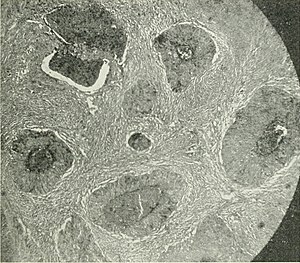Bartholin gland carcinoma
| Bartholin gland carcinoma | |
|---|---|
| Synonyms | Bartholin's gland cancer, Bartholin's gland carcinoma (morphologic abnormality), carcinoma of Bartholin's gland (disorder) |
 |
|
| Barthlin carcinoma tissue cross section | |
| Classification and external resources | |
| Specialty | Oncology, gynecology |
| ICD-10 | N75 |
| MeSH | D003528 |
Bartholin gland carcinoma is an uncommon type of malignancy in the Bartholin gland that accounts for 1% of all vulvar malignant neoplasms. It is most common in women in their mid-60s. The tumor can become large before a woman is aware of symptoms. One of the first symptoms can be dyspareunia. In other instances a woman may find a mass or ulcer in the vulva area. Many clincians assume that an enlarged Bartholin gland is malignant in postmenopausal woman until proven otherwise. The growth of the tumor can spread to nearby areas such as the ischiorectal fossa and inguinal lymph nodes. Approximately 50% of bartholin gland carcinomas originate from squamous cell carcinomas. Another uncommon characteristic of Bartholin gland malignancies is that the growth of a lesion originates from the three types of epithelial tissue present in the gland: mucinous, transitional, and squamous.
Though Bartholin gland carcinoma is rare, along with other unusual Bartholin gland growths, it many not be the typical practice for clinicians to consider lesions malignant. Early diagnosis can help to prevent the cancer from the glands to surrounding. Though malignancies of the Bartholin gland are rare clinicians biopsy Bartholin gland lesions in older women or when the growth reoccurs or does not respond to original treatment.
The prognosis is optimistic as long as the growth has not metastasized to the lymph nodes.
Bartholin glands were described in cattle by Casper Barthlin in 1677. Their existence in humans was postulated at that time. Treatment can be a vulvectomy that results in the removal of the growth along with an extensive removal of adjacent tissue. An iguinal lympenectomy often accompanies the vulvectomy. The tissue that is removed sometimes includes sections of the vagina and rectum.
...
Wikipedia
